
Wedding photography is a competitive field, and getting noticed online can be challenging. That’s where SEO (search engine optimization) comes in.
Think of it as a way to help couples searching for photographers find you—right when they’re looking. By optimizing your website and content, you can rank higher on search engines for popular terms like “wedding photographer near me” and generate a steady stream of new business.
Whether you’re just starting with SEO or want to fine-tune your approach, this guide will give you the best SEO tips to boost your visibility, attract more leads, and book more weddings.
What is SEO for Wedding Photographers?
SEO for wedding photographers is about making your website appear when couples search for services like yours.
It includes using keywords like “wedding photographer [city],” speeding up your site and creating valuable content that resonates with your audience. When done right, SEO helps your website rank higher in search engine results pages so more people can find you.
It’s not just about visibility; it’s about connecting with couples who are ready to book their dream photographer—you!
Why is SEO for Wedding Photographers Important?
Imagine a couple searching for “best wedding photographers in [your city].” If your website ranks on the first page, you’re far more likely to get their attention and booking than someone buried on page three. That’s the power of SEO.
By optimizing your website, you can attract highly targeted visitors. For example, the keyword “wedding photographer near me” has a monthly search volume of 1.6k. Ranking for this term could bring in hundreds of potential clients to your site monthly and take traffic away from other wedding photographers.
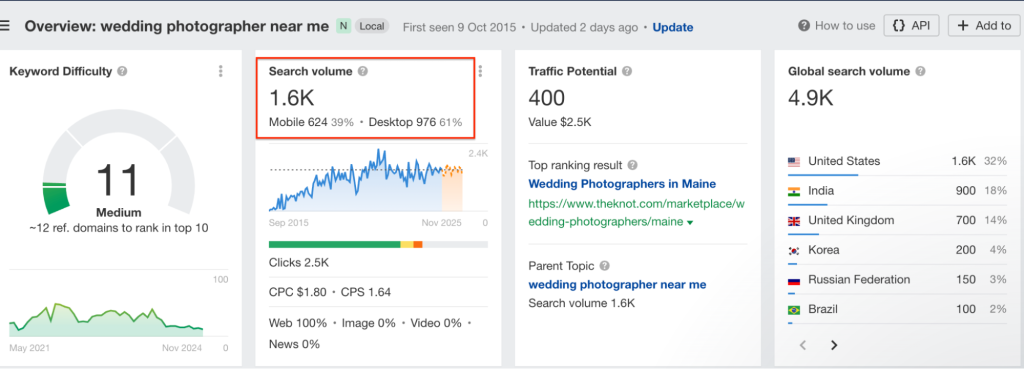
Source: Ahrefs
SEO offers several key benefits that make it essential for growing your wedding photography business:
🏆 Long-term visibility and traffic. Unlike paid ads, which stop driving traffic once your budget runs out, SEO provides consistent visibility and traffic over time. This makes it a cost-effective way to attract potential clients.
🏆 Builds credibility. Websites that rank at the top of Google are often viewed as more trustworthy, helping you establish credibility with potential clients.
🏆 Local optimization for more bookings. Optimizing for local keywords, such as “wedding photographer near me,” makes it easier for nearby clients to find and book your services.
🏆 Round-the-clock online presence. When paired with positive reviews and a mobile-friendly site, SEO creates a powerful online presence that works 24/7 to attract and convert clients.
8 Steps For Wedding Photographers to Boost their SEO
Find Relevant Keywords
Understanding what people are searching for online is crucial to attracting engaged couples and clients in your area.
Conducting keyword research lets you identify the words and phrases your ideal clients use to find wedding photography services. Ahrefs is a powerful SEO tool that can help you discover these keywords, analyze competitors, and choose the best terms to boost your visibility.
| 💡Key point: Why keyword research matters for wedding photographers
Keyword research helps you target high-impact keywords, like “wedding photographer in [your city]” or “affordable wedding photographers,” that people use to search for your services. By targeting these keywords, you’ll increase your chances of appearing in search results, making it easier for couples to find you and view your portfolio. |
How to do keyword research with Ahrefs
1️⃣ Log In to Ahrefs
First, log in to your Ahrefs account. If you’re new to Ahrefs, you can start with a Starter package for $29 /mo to explore its features.
2️⃣ Navigate to the Keyword Explorer tool
In the Ahrefs dashboard, select Keyword Explorer from the top menu. This tool will let you search for keyword ideas and view detailed data on each term:
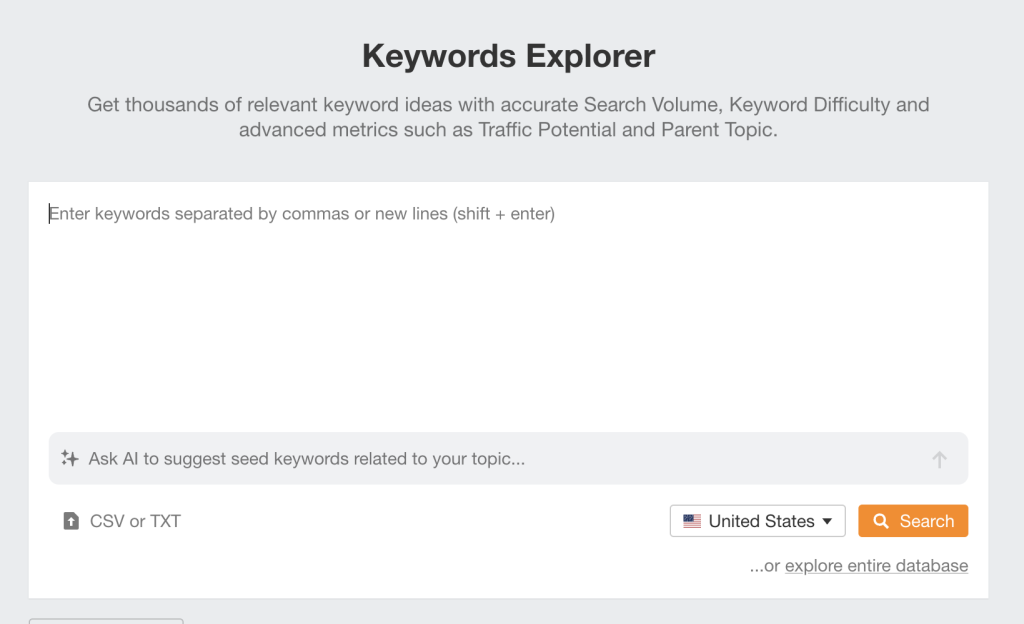
Source: Ahrefs
3️⃣ Enter Keywords related to wedding photography
Begin with broad terms that relate to the wedding photography services you offer, such as:
- “wedding photographer [your location]”
- “destination wedding photographer”
- “elopement photographer [city or country]”
- “wedding photo ideas”
- “engagement photography session”
Click search, and Ahrefs will display data for each keyword, including:
📊Search volume: How many people search for a term each month. High search volume indicates high demand, but balancing this with competition is essential.
📊Keyword difficulty: Indicates how hard it is to rank for a keyword. Lower-difficulty keywords are ideal for new sites or niche terms like “intimate elopement photography.”
📊Traffic potential: Provides an estimate of how much traffic you could expect if you ranked for this keyword. Higher potential means more visitors to your site.
Below, we’ve used the keyword “wedding photographer” to illustrate this:

Source: Ahrefs
For example, our keyword “wedding photographer” has a search volume of 9,000, with a traffic potential of 4,700. It also has a keyword difficulty of 26, which means it’s relatively easy to rank organically.
4️⃣ Look at keyword suggestions
Ahrefs also provides suggestions for secondary keywords based on your main keyword:

Source: Ahrefs
These related keywords help you uncover long-tailed keywords, like:
- “Wedding photographer cost” (2.1k)
- “Wedding photographer near me” (1.6k)
- “Average wedding photographer cost” (1.6k)
These long-tail keywords (longer, more specific phrases) often have lower competition and higher conversion potential because they are more targeted and likely to attract clients looking for specific information, like the cost of a wedding photographer.
| 💡Pro-tip: Make a list of good keywords as you go. You can always refine this list later on. |
5️⃣ Review the SERPs
Ahrefs lets you review the top-ranking pages for your target keywords. Check the top results to see what kind of content is performing well. If the top results are mostly listicles, how-tos, or personal blog posts, this can give you ideas for creating content that competes:

Source: Ahrefs
6️⃣ Export your keyword list
Once you’ve found relevant keywords, click “View All” under “Keyword Ideas,” then select “Export” to download your list. This will help you keep track of keywords you want to target in your site’s content, blog posts, and other areas.
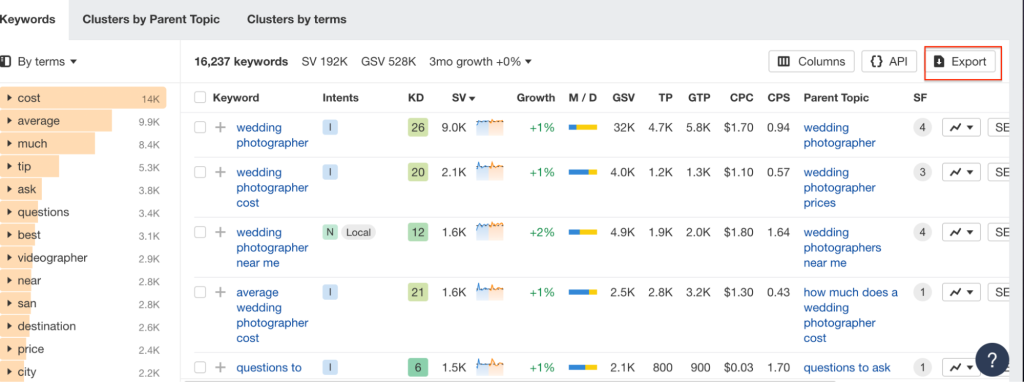
Source: Ahrefs
| 💡Pro-tip: Don’t have access to keyword research tools?
Don’t worry! To look for target keywords, you can use free keyword research tools like Google Keyword Planner or Moz Keyword Explorer to help you with keyword research. |
Optimizing images for SEO as a wedding photographer
As a wedding photographer, your website likely features hundreds of high-quality images. While these showcase your talent beautifully, they can also slow down your website’s load time if not optimized correctly. Image optimization is essential for creating a faster user experience and improving your site’s search engine ranking, ensuring potential clients don’t leave your site before they’ve even seen your work.
Here’s how to optimize your images effectively:
Resize and compress your images
➡️ Why it matters: Large image files can slow down your site, affecting the user experience and SEO. Search engines favor sites with fast load times, and clients are likelier to stay on a site that loads quickly.
✅ How to do it: Resize images to fit your site layout, aiming for a maximum width of around 1200-1500 pixels for standard photos. Compress images using tools like TinyPNG, JPEG-Optimizer, or Photoshop to reduce file size without losing quality. This ensures your images look great without sacrificing performance.
Choose the correct file format
➡️ Why it matters: Different file formats have different strengths. Using the correct format will ensure your images look good and load quickly.
✅ How to do it: Use JPEG for high-quality photos, as it balances quality and file size. For graphics, logos, or images with transparency, use PNG. Avoid using high-resolution RAW files, as they are large and not optimized for the web.
Add alt text to images
➡️ Why it matters: Alt text (alternative text) helps search engines understand the content of an image. It also improves accessibility for visually impaired users by describing the image to screen readers.
✅ How to do it: Write a concise description of each image that includes relevant keywords naturally. For example, “Bride and groom exchange vows at sunset beach wedding.” Avoid keyword stuffing—just describe the image in a way that’s informative and relevant to the content.
Enable lazy loading
➡️ Why it matters: Lazy loading delays loading images until they’re about to appear on the viewer’s screen. This reduces initial load time, improves the browsing experience, and helps with SEO.
✅ How to do it: Most content management systems (CMS), like WordPress, offer lazy loading plugins or may be built-in. Enabling lazy loading ensures that only images in the viewer’s immediate view load initially, speeding up the page.
Use a Content Delivery Network (CDN)
➡️ Why it matters: A CDN stores copies of your images on multiple servers worldwide, so they load quickly for users regardless of location. This improves load time, especially if you attract clients from different regions.
| 💡Key point: What is a CDN? A CDN (Content Delivery Network) is a group of geographically distributed servers that speed up web content delivery by bringing it closer to where users are. |
✅ How to do it: Popular CDN services like Cloudflare or Amazon CloudFront can be easily integrated with most websites. Your hosting provider may also offer a CDN option.
Create a Structured Image Sitemap
➡️ Why it matters: An image sitemap helps search engines find and index all the images on your site, improving your chances of appearing in image search results.
✅ How to do it: If you’re using WordPress, plugins like Yoast SEO or the Angel Digital sitemaps generator can create one for you. Submit this sitemap to Google Search Console to ensure all images are indexed.
Publish content
Blogging is one of the most powerful tools for a wedding photographer to attract potential clients. By sharing insights, tips, and stories of your experiences, you can showcase your style, connect with engaged couples, and improve your wedding photography SEO.
Why Blogging Matters for SEO
Regularly publishing blog posts keeps your website active and fresh in the eyes of search engines.
Every new post gives you an opportunity to use relevant keywords that potential clients are searching for, such as “destination wedding photographer,” “best engagement shoot locations,” or “boho wedding inspiration.”
Over time, these targeted posts can help your site rank higher, making it easier for couples to find you.
What to blog about as a wedding photographer
🩷 Showcase real weddings
Feature detailed posts that capture wedding photography examples, including challenges overcome and unique moments captured. For example, photographer Roberta Facchini shares real-life wedding stories on her blog. She uses keywords for SEO in her blog post titles:

Source: Roberta Facchini
🩷 Wedding tips and advice
Offer advice on how to prepare for a photo shoot; for example, on Aden Priest’s photography website, he has a guide on how to plan for good light on your wedding day:
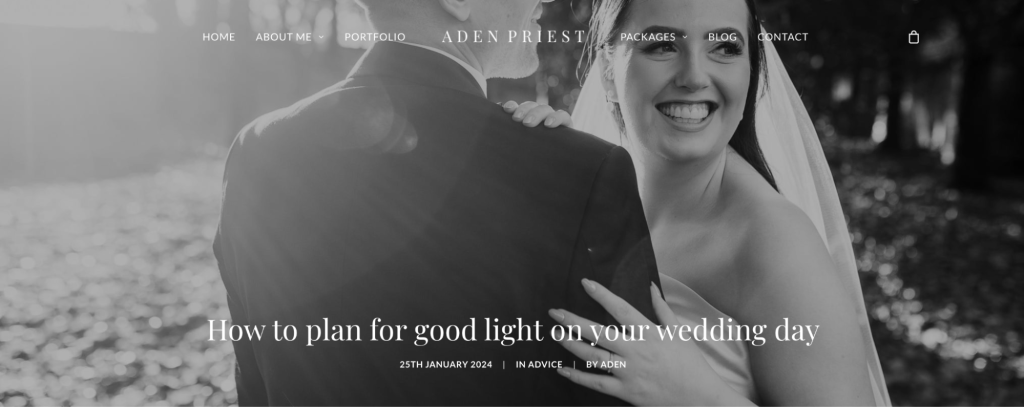
Source: Aden Priest
🩷 Behind-the-scenes stories
Show a glimpse of what it’s like to work with you. This can include preparing for a wedding shoot, editing processes, or how you captured a specific shot. Sharing your perspective helps potential clients understand your unique style and approach. For example, Elizabeth Gelineau shared this article on what it’s like behind the scenes:

Source: Elizabeth Gelineau
🩷 Seasonal or themed shoots
Post seasonal or themed ideas, like fall weddings or beach elopements. These attract clients with specific interests and showcase your range of skills. For example, this blog post on fall weddings gives some inspiration for couples looking to get married at this time of year:
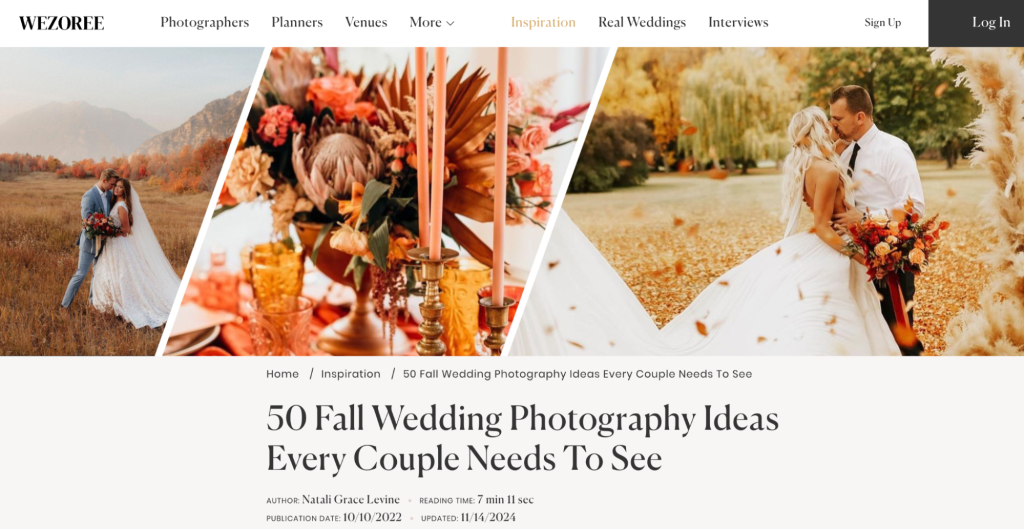
Source: Wezoree
🩷 Answer Frequently Asked Questions (FAQs)
Couples planning their wedding often have many questions, and addressing them in blog posts positions you as a helpful and knowledgeable professional. For example, this article breaks down how much wedding photography packages cost for the reader:

Source: Wedissimo
Blogging Best Practices
✅ Use high-quality images: As a wedding photographer, images are your strength, so make sure each blog post includes a selection of your best shots. Images enhance user engagement and help bring your story to life.
✅ Incorporate keywords naturally: Identify relevant keywords for each blog post, such as “[Your City] Wedding Photographer” or “Top Engagement Shoot Ideas,” and weave them naturally into your content. Use keywords in the title, headings, and alt text of images for an SEO boost.
✅ Write for your audience, not just search engines: While keywords are important, the content should feel engaging and authentic. Write in a way that speaks to engaged couples, offering advice and insights that they’ll find valuable and relatable.
✅ Add internal links: Link to other pages on your site, like your portfolio, contact page, or related blog posts, to help visitors explore more of your work and improve your site’s SEO structure. For instance, in the guide we shared above on how much wedding photographers cost, they have linked to a survey they conducted on wedding photography prices in the UK. This not only enriches the content but also encourages readers to stay longer on the site:
Source: Wedissimo
✅ Post regularly: Consistency is key to a successful blog. Aim for at least one post per month, but even once every few months can help keep your site active. The more regular your posts, the better your chances of building momentum with SEO.
| 💡Pro-tip: Share your blog to reach more clients
Once you publish a post, share it on social media platforms like Instagram, Facebook, and Pinterest to attract more readers and potential clients. You can also contact the vendors or venues you featured to let them know about the post—they may share it with their own audience, expanding your reach. |
Set up Google My Business and other directories
Most wedding photographers focus on serving clients within specific local areas. To help potential clients find you, set up profiles on photography-related directories like The Knot, WeddingWire, and Zola.

Source: Zola
These directories, known as local citations, act as online references for your business, increasing your visibility and credibility.
Local citations make it easier for couples to find your wedding photography business. They also strengthen your SEO by signaling to search engines that your business is legitimate, locally relevant, and trusted within your community.
Google Business Profile
One of the most important citations to prioritize as a wedding photographer is your Google Business Profile.
An optimized Google Business Profile boosts your local SEO and helps you appear in local searches. With a well-maintained profile, you could even secure a spot in the coveted Local Pack at the top of search results.
What is the “Local Pack”?
The Local Pack is a highly visible section in search results for local services. For example, if a couple searches “wedding photographer in [Your City],” the Local Pack displays a select group of photographers with reviews and locations on Google Maps:

Source: Google
Securing a top spot in local search results isn’t achieved through luck; you must optimize your Google Business listing, generate reviews, and maintain consistent citations across local directories. Here’s how to set up your profile:
How to set up your Google Business Profile for your wedding photography business
1️⃣ Create or sign in to your Google Account
2️⃣ Go to Google Business Profile
3️⃣ Add or claim your business: You can claim and verify ownership if your photography business is already listed. If not, click “Add your business” or “Manage now” to begin the setup process.
4️⃣ Provide accurate and complete information:
- Business Name (e.g., “[Your Name] Photography”)
- Address (or specify a service area if you don’t have a studio)
- Phone Number
- Website URL
- Business Category (e.g., “Wedding Photographer” or “Event Photographer”)
- Service Areas (cities or neighborhoods you serve)
- Business Hours
5️⃣ Verify your business: Google typically sends a postcard with a verification code to your address. Enter the code on your Google Business dashboard to complete the verification.
| 💡Pro tip: Alternatively, verification methods may be available depending on your account. Check your Google Business dashboard for options. |
6️⃣ Optimize your listing: Once verified, enhance your profile with additional details to stand out:
- A compelling business description that highlights your style, specialties, and unique approach.
- High-quality photos of your best work, including wedding scenes, venues, and couple portraits.
- Regular posts about recent weddings, special offers, or photography tips to engage potential clients.
- Client reviews, which help build trust and showcase your expertise.
Optimize pages for keywords
On-page SEO is an essential part of your wedding photography SEO strategy. It involves optimizing elements on your website so search engines can easily understand, navigate, and index it. These improvements boost your search rankings and create a more seamless experience for potential clients.
Here’s a checklist of key on-page elements to optimize:
Title tags
Title tags are clickable headlines appearing in search engine results. They tell users and search engines what each page is about. For wedding photographers, well-crafted title tags can help attract engaged couples searching for your services.
ℹ️ Example of a title tag:

Source: Google
| 💡 Pro tip: Include your main keyword and location to boost your local SEO. |
Meta descriptions
Meta descriptions are summaries that appear below the title tag in search results. They give users a quick overview of your page and encourage them to click.
ℹ️ Example of a meta description:

Source: Google
| 💡Pro tip: Keep your meta descriptions under 155 characters and include a call-to-action. |
Headings (H1, H2, etc.)
Headings structure your content, making it easier for users and search engines to read and understand. Use an H1 for the main title and H2s and H3s for subheadings.
ℹ️ Example:
H1: “Stunning Wedding Photography for Every Moment”
H2: “Why Choose Us for Your Wedding Day”
H3: “Our Unique Photography Style”
Image alt text
As previoulsy mentioned, alt text improves wedding photographer SEO and accessibility by describing your images for search engines and visually impaired users. It’s an excellent opportunity for wedding photographers to include keywords while showcasing their work.
ℹ️ Example of alt text:
“Bride and groom dancing at sunset in Napa Valley vineyard, photographed by Jane Doe Photography.”
Keyword usage
Use relevant keywords naturally throughout your content. For wedding photographers, this might include phrases like “destination wedding photographer,” “beach wedding photos,” or “[Your City] wedding photography.”
| 💡Pro tip: Include keywords in critical areas like your title tag, meta description, headings, and image alt text—but avoid overloading your content with keywords, as this can harm your SEO. |
Build backlinks
The next step in your SEO strategy is building backlinks—links from other websites that direct users to your site. Think of them as digital referrals: when another site links to your content, it’s like they’re endorsing your work and saying, “This is worth checking out!”
Backlinks are critical in wedding photography SEO because search engines see them as a sign of your website’s credibility, authority, and relevance.
For wedding photographers, high-quality backlinks are particularly valuable. They help boost your Google ranking, making it easier for engaged couples to find your services. However, it’s not just about quantity—quality backlinks from relevant websites carry far more weight than multiple links from unrelated sources.
Below are some strategies tailored for wedding photographers to build more high-quality backlinks effectively:
Guest posts on wedding blogs
Contributing articles to reputable wedding blogs or photography blogs allows you to showcase your expertise and gain valuable backlinks. For instance, photographer Jim Harmer shared some tips on how to edit wedding photos on the Improve Photography blog:

Source: Improve Photography
How to find guest posting opportunities
✅ Target niche blogs: Look for wedding blogs or publications like The Knot or WeddingWire that accept guest posts.
✅ Use Google search operators: Search for phrases like “write for us wedding photography” or “submit guest post-wedding planning.”
✅ Join wedding communities: Participate in wedding forums or groups like WeddingBee to connect with bloggers who may welcome guest contributions.
Establish relationships with other wedding vendors.
Establish partnerships with venues, planners, florists, and other vendors. You create mutually beneficial backlinks by featuring each other’s work on your respective websites and linking back.
For example, highlighting a venue you’ve worked at and linking to their site can encourage them to do the same for you.
Image link building
As a wedding photographer, your stunning images are valuable for link-building. Offering free photos in exchange for a backlink is an effective way to grow your online presence and SEO while showcasing your work to a broader audience.
Many blogs, businesses, and vendors in the wedding industry are constantly looking for high-quality visuals. Offering your photos for free in exchange for a backlink is a win-win situation—they get stunning images, and you gain visibility and credibility.
Here’s how to get started:
➡️ Share images with vendors you’ve worked with, like wedding venues, florists, or planners. Suggest they use your photos in their online portfolios or blog posts and link back to your website.
➡️ Offer free images to wedding blogs for articles. Websites like The Knot or WeddingWire are always looking for content.
➡️ Contribute to stock photo sites that specialize in weddings. Platforms like Unsplash or Pexels allow you to share photos for free, often resulting in backlinks when users credit your work.
| 💡 Key Point: Get permission from clients before sharing their photos
Always ask your clients for permission before using wedding photos for link-building purposes. While most couples will be excited to see their photos featured, respecting their privacy and any concerns they may have is essential. You can include a clause in your photography contract or simply ask for their consent when discussing the potential use of their images. |
Use Image Link Building to get credit for your work
Sometimes, your photos might already be used online without proper credit or a backlink to your site. You can reclaim those links and improve your SEO by tracking these instances and reaching out to the website owner and asking them to link to yor site. Here’s how:
Use reverse image search tools like Google Images or specialized tools like TinEye to find where your images are being used online:

Source: TinEye
If you discover an instance where your photo is published without proper credit, politely contact the website owner. A simple request asking them to add a link to your site often works well.
| 💡 Pro tip: Ensure your photos have metadata (like your business name and website) embedded in the file before sharing. This makes it easier for people to trace the image back to you |
Optimize social media profiles
Your social media profiles can be a powerful part of your backlink strategy. Platforms like TikTok, Instagram, Facebook, and Pinterest allow you to link directly to your website, driving traffic and boosting visibility.
While these links are often “no-follow” (meaning they don’t pass SEO authority), they still contribute to your overall online presence and can attract referrals.
✨Need inspiration? Check out wedding photographer Caitlin Cooper’s Instagram profile. Notice how she uses a consistent brand image, an engaging bio, and a direct link to her website, making it easy for potential clients to learn more about her work:

Source: Instagram
Ensure your wedding photography site is fast and mobile-friendly
When couples search for their perfect wedding photographer, they expect a seamless online experience—especially on their phones. If your wedding photography website loads slowly or isn’t optimized for mobile devices, you risk losing potential clients before they even see your work.
A fast, mobile-friendly website ensures visitors can effortlessly browse your portfolio, read your blog, and contact you, no matter their device. It also boosts your SEO, as search engines prioritize fast-loading, mobile-optimized sites.
Here’s why mobile-friendliness and site speed matters for wedding photographers:
ℹ️ Most couples search on mobile: Many engaged couples browse photography sites on their phones, often while planning on the go. If your site isn’t mobile-friendly or loads too long, they might leave and choose a competitor instead.
ℹ️ Google prioritizes speed and mobile optimization: Google uses mobile-first indexing and considers site speed as a ranking factor. A site that loads quickly and adapts perfectly to mobile devices is more likely to appear at the top of search results.
ℹ️ Better user experience equals more bookings: A fast, mobile-optimized site keeps visitors engaged. The easier it is to navigate your galleries, read your blog, and fill out your contact form, the more likely they’ll inquire about your services.
How to test your site’s mobile friendliness
You can check your site’s mobile performance with Google Search Console’s Core Web Vitals report, which gives insights on things like loading speed, interactivity, and visual stability. You’ll get a clear picture of where your site might need some tweaks:

Source: Debug Bear
Another handy tool is HubSpot’s Website Grader, which is free and evaluates your site’s mobile responsiveness, speed, and overall performance—great for a quick, detailed overview.
How to make your site mobile-friendly
✅ Use a responsive design: Ensure your website design automatically adjusts to fit different screen sizes. Most modern templates from platforms like WordPress or Squarespace are built with responsive design in mind.
✅ Optimize your images: Compress large images so they load quickly on mobile devices without sacrificing quality. Fast-loading images keep visitors engaged and improve SEO.
✅ Simplify navigation: Your wedding photography website should have clear menus and large, easy-to-tap buttons that make it effortless for visitors to browse your galleries, read your blog, or contact you for bookings.
✅ Avoid pop-ups: Pop-ups can be frustrating on mobile devices and may drive users away. Minimize or avoid them entirely to ensure a smooth browsing experience.
✅ Speed up your site: Use tools like Google PageSpeed Insights to analyze your site’s performance and identify areas to improve. Compress files, enable browser caching, and minimize scripts to keep your site loading fast.
Need SEO Services for Your Wedding Photography Business?
Growing your online visibility as a wedding photographer can be challenging, but you don’t have to go it alone. Authority Builders specializes in helping creative professionals like you attract the right audience with proven SEO strategies.
Here’s how we can help:
👑 Link Building: Gain high-quality backlinks that improve your site’s authority and ranking.
👑 Guest Posting: Share your expertise on wedding and lifestyle blogs to reach more clients.
👑 Digital PR: Get featured in online publications to enhance your brand’s credibility.
👑 Citation Building: Boost your local SEO to make it easy for nearby couples to find and book your services.
Ready to stand out and connect with couples who love your style? Sign up today, and let’s build a strong SEO foundation for your wedding photography business!
